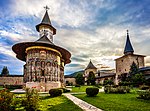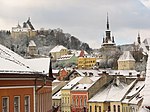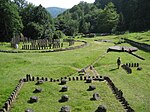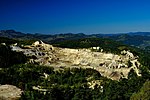Lyulyoot A̱ka̱vwuo Nkhang Swanta mi̱ Romaniya
| A̱byin | Romaniya |
|---|---|
| Official website | https://whc.unesco.org/en/statesparties/ro |
A̱ka̱vwuo Nkhang Swanta Sot-nta̱m Tat-a̱pyia̱, Sayen ma̱ng Taada Muná̱pyia̱ Bibyin Swanta (UNESCO) na yet a̱ka̱vwuo nia na̱ yet a̱tsatsak a̱ni mami taada ku swanta hu nang á̱ ku wa̱i ndyo ma̱ A̱tung Taada Swanta UNESCO ka, nang á̱ ku kpaat ma̱ a̱lyia̱ 1972.[1] Ci̱t taada byia̱ ma̱ nhu a̱ka̱nok jhyung nkyang ku á̱niet (nang nta̱m ghwang a̱ka̱sa, nghwughwu nang á̱ myiri̱m a̱ni mat jhyung kyang ku a̱yin, ku lyuut lilyuut nang á̱ ta̱zut a̱ni), susot a̱ka̱nok, ma̱ng a̱ka̱vwuo (nang a̱ka̱vwuo nang á̱ lung á̱ ti̱n ku á̱ tyai nkyang gbangbang a̱ni). Nkyang na na̱ nwai yet nyia̱ a̱tyubishyi a̱ni (nang nkyang na̱ byia̱ vam nang á̱ maai á̱ li á̱ la a̱ni ma̱ng nkyang na na̱ yet a̱ka̱mat A̱gwaza nia a̱ni), tak ti̱tak tat-a̱pyia̱ a̱byin ma̱ng nkyang maai nyia̱ ji̱ yet a̱mat A̱gwaza ja a̱ni (nang a̱ka̱vwuonswat susot nyám ma̱ng á̱ga̱fi̱p jhyang na̱ shyia̱ a̱bwonu tyiai a̱ni), mbeang a̱ka̱vwuo na̱ yet nang A̱gwaza ku mat a̱ sak a̱ni na̱ si̱ yet a̱tsatsak mi̱ di̱ nwuan sains, cok-nkyang ku a̱za̱za̱rak shisham, a̱mgba̱m á̱ kwok na̱ fa nkyangci̱t a̱kwa-swanta nia.[2] A̱byin Romaniya ku shim a̱lyiat a̱tung na ma̱ a̱tuk 16 Zwat Tswuon 1990, ka̱ si̱ tyia̱ a̱ka̱vwuo nkhang nka na na̱ si̱ shyia̱ nwuo mi̱ lyulyoot hu.[3]
Mi̱ da̱ a̱lyia̱ 2022, á̱ ku mbyia̱ A̱ka̱vwuo Nkhang Bibyin Swanta a̱kubunyiung nia mi̱ Romaniya,[3] a̱wot a̱natat si̱ yet a̱ka̱vwuo taada nia ma̱nang a̱feang si̱ yet a̱ka̱vwuo za̱nang swanta nia. Á̱ ku mbeang a̱son a̱vwuo ka mi̱ Romaniya, Da̱li̱ta Da̱nube ji, di̱ lyulyoot hu di̱n jen Nyia̱ 15 Komiti Nkhang Swanta ji ja, á̱ ku nyia̱ mi̱ Ka̱ri̱tago ma̱ a̱lyia̱ 1990. Á̱ bu si̱ mbeang a̱ka̱vwuo á̱ghyang mi̱ ndyia̱ 1993 ma̱ng 1999 a̱wot á̱ si̱ ba̱ ngaat á̱ghyang ma̱ a̱ka̱vwuo na. A̱vwuo ngaan ka nang á̱ mbeang fi̱ lyulyoot hu a̱ni, kikya yet Roșia Montană Mining Cultural Landscape, ma̱ a̱lyia̱ 2021, a̱wot a̱ si̱ mbeang nka kiki di̱ lyulyoot A̱ka̱vwuo Nkhang Swanta ku myim Cok a̱ni mat khwom ya-a̱son ma̱ng lung a̱byin da̱ a̱vwuo a̱kya mat cat a̱tsatsak nfang. Bibyin Yurop 18 hwa ka̱u a̱vwuo ka Á̱khwukhwop ma̱ng A̱tsak Susop Khwong Ka̱pat ma̱ng Nfam Yurop Nghyáng. Mameang, á̱ mbyia̱ a̱ka̱vwuo 16 mi̱ lyulyoot ku nwai yet si̱ di̱ngdi̱ng a̱ni si̱ Romaniya.[3]
A̱ka̱vwuo Nkhang Swanta
[jhyuk | jhyuk a̱tyin ka]UNESCO ku fang lyulyoot tafa ta̱fwat swak; ta hwa kuzang nwuo ku myim ta̱fwat jhyiung ku si̱ ku lan a̱wa. Tá̱fwat i ba̱ng si̱ nat vi yet si̱ taada ja, a̱wot vii ba̱ng si̱ nat x yet si̱ za̱nang swanta ja.[4]
| A̱vwuo | Ghwughwu | A̱gbang | A̱lyia̱ nwuai lyulyoot | deita UNESCO | Wa̱i a̱lyiat |
|---|---|---|---|---|---|
| Da̱li̱ta Da̱nube | 
|
[[Sot A̱gwomna̱ti Mali Tuli̱kea | 1991 | 588; vii, x (za̱nang swanta) | Da̱lita Da̱nube ji, a̱ja wa a̱ghyui Da̱nube ka nwuai ma̱ A̱dyundyung Kyai A̱sa̱khwot wu, ja yet a̱byin-nian ka̱ swak ma̱ng shi hu mami Yurop a̱mgba̱m. A̱mali a̱ka̱man na̱ na swak 300 ma̱ng ntangka̱i fa̱n a̱shyim a̱sa̱khwot 45, mbeang a̱man sturgeon ka ka̱ shyia̱ a̱bwonu bwuk kya ji̱ yet. Á̱ si̱ mbyia̱ ntangka̱i nyam na̱ nwaai mman nna na nang ming Yurop, a̱kwi a̱yit Yurop, otta Yurasiya, ma̱ng the threatened monk seal nang á̱ kat a̱ni ba̱t.[5][6] |
| A̱baka̱keang ma̱ng Ncot na̱ byia̱ A̱ka̱ndi̱ri̱m Cok a̱ni mi̱ Ti̱ransi̱li̱vaniya | 
|
Sibyu, A̱li̱ba, Harghita, Brașov, ma̱ng Mureș County | 1993 | 596bis; iv (cultural) | This site comprises seven villages with fortified churches that were built between the 13th and the 16th centuries by Transylvanian Saxons. The settlement pattern and the organization of the villages has been preserved since the Middle Ages. Six villages (Câlnic, Dârjiu, Prejmer, Saschiz, Valea Viilor, and Viscri) were listed in the original nomination in 1993 while the village of Biertan (the fortified church is pictured) was added in 1999.[7] |
| Monastery of Horezu | 
|
Vâlcea County | 1993 | 597; ii (cultural) | The monastery in the town of Horezu was founded in 1690 by Constantin Brâncoveanu, Prince of Wallachia, who was the namesake of the Brâncovenesc style of architecture. It is considered by UNESCO as a masterpiece of this style. It is known for its rich ornamental details and votive paintings. In the 18th century, an influential school of mural and icon painting was established in the monastery.[8] |
| Churches of Moldavia | 
|
Suceava County | 1993 | 598bis; i, iv (cultural) | This site comprises eight churches built in the 15th and 16th centuries. In line with the regional period style, the facades of the churches are entirely covered by frescos inspired by Byzantine art. The paintings depict Biblical themes and are well preserved. The churches include the Beheading of Saint John the Baptist Church, the Assumption of the Virgin and of Saint George's Church of the Humor Monastery, the Church of the Annunciation of Moldovița Monastery, the Sacred Cross Church, the Saint Nicolas' Church of Probota Monastery, the Saint John the New Monastery, the Saint George's Church of the former Voroneț Monastery, and the Church of the Resurrection of Sucevița Monastery (pictured). The latter church was added to the list in 2010.[9][10] |
| Historic Centre of Sighișoara | 
|
Mureș County | 1999 | 902; iii, v (cultural) | The historic centre of the city of Sighișoara dates from the 12th century. It is a well-preserved example of a small fortified medieval town shaped by the interactions of cultures from Central Europe and the Byzantine-Orthodox Southeastern Europe. It was founded by the Transylvanian Saxons, a community of German merchants and craftsmen. They have lived in the region for over 850 years, however, due to immigration in modern times, their culture will be preserved only through architectural monuments.[11] |
| Wooden Churches of Maramureş | 
|
Maramureș County | 1999 | 904; iv (cultural) | This site comprises eight churches from the 17th and 18th century in Maramureș County. The churches are made of wood and they combine influences of Orthodox and Gothic architecture styles. Some of the common characteristics of the churches include tall, slim clock towers and roofs covered by shingles. The list includes the Church of the Presentation of the Virgin in the Temple in Bârsana, the Church of Saint Nicholas (pictured) in Budești, the Saint Parascheva Church in Desești, the Church of the Nativity of the Virgin in Ieud Deal, the Church of the Holy Archangels in Plopiș, the Saint Parascheva Church in Poienile Izei, the Church of the Holy Archangels in Rogoz, and the Church of the Holy Archangels in Șurdești.[12][13] |
| Dacian Fortresses of the Orăștie Mountains | 
|
Hunedoara County and Alba County | 1999 | 906; ii, iii, iv (cultural) | The six fortresses that comprise this site, Sarmizegetusa, Costeşti-Cetăţuie, Costeşti-Blidaru, Luncani-Piatra Roşie, Bănița, and Căpâlna, were built in the 1st century BCE and 1st century CE and served as protection against Roman conquest during the Roman-Dacian wars. They are representative examples of two characteristic types of forts of Late Iron Age Europe, the hilltop fort and its successor which evolved from it, the oppidum.[14] |
| Ancient and Primeval Beech Forests of the Carpathians and Other Regions of Europe* | 
|
several sites | 2017 | 1133quater; ix (natural) | This site comprises undisturbed examples of temperate forests that demonstrate the postglacial expansion process of European beech from a few isolated refuge areas in the Alps, Carpathians, Dinarides, Mediterranean, and Pyrenees. The site was originally listed in 2007 as the Primeval Beech Forests of the Carpathians, shared by Slovakia and Ukraine, extended in 2011 to include the Ancient Beech Forests of Germany, extended in 2017 to list 12 areas in Romania and in some other countries, and further expanded in 2021 to include forests in a total of 18 countries.[15] |
| Roșia Montană Mining Cultural Landscape |

|
Alba County | 2021 | 1552rev; ii, iii, iv (cultural) | Roșia Montană is located in the western part of the Romanian Carpathians. The area is rich in deposits of precious metals and has been a centre of gold mining starting in Bronze Age and continuing in the 21st century. Before the discovery of America, the area was the main European source of gold. Important remains date from Roman times, when the mining town of Alburnus Maior was founded. In the medieval period, mining was mostly carried out by families of peasant-miners, this pre-industrial practice continued until the nationalisation in 1948.[16] Upon the inscription, the site was immediately listed as endangered due to threats posed by plans to resume mining.[17] |
Ya̱fang
[jhyuk | jhyuk a̱tyin ka]- ↑ "The World Heritage Convention". UNESCO World Heritage Centre. Archived from the original on 23 Zwat Tswuon 2016. Retrieved 17 Zwat A̱kubunyiung 2010.
- ↑ "Convention Concerning the Protection of the World Cultural and Natural Heritage". UNESCO World Heritage Centre. Archived from the original on 1 Zwat Sweang 2021. Retrieved 3 Zwat Sweang 2021.
- ↑ 3.0 3.1 3.2 "Romania". UNESCO World Heritage Centre. Archived from the original on 10 Zwat Tswuon 2021. Retrieved 9 Zwat Tswuon 2021.
- ↑ "UNESCO World Heritage Centre – The Criteria for Selection". UNESCO World Heritage Centre. Archived from the original on 12 Zwat A̱taa 2016. Retrieved 17 Zwat A̱ni̱nai 2018.
- ↑ "Danube Delta". UNESCO World Heritage Centre. Archived from the original on 27 Zwat Jhyiung 2008. Retrieved 9 Zwat Tswuon 2021.
- ↑ "Danube Delta Biosphere Reserve". UNESCO World Heritage Centre. Archived from the original on 4 Zwat Jhyiung 2017. Retrieved 9 Zwat Tswuon 2021.
- ↑ "Villages with Fortified Churches in Transylvania". UNESCO World Heritage Centre. Archived from the original on 10 May 2021. Retrieved 9 May 2021.
- ↑ "Monastery of Horezu". UNESCO World Heritage Centre. Archived from the original on 8 May 2021. Retrieved 9 May 2021.
- ↑ "World Heritage Committee also approves three extensions to World Heritage properties in Austria, Romania and Spain". UNESCO World Heritage Centre. Archived from the original on 5 August 2010. Retrieved 20 September 2010.
- ↑ "Churches of Moldavia". UNESCO World Heritage Centre. Archived from the original on 9 May 2021. Retrieved 9 May 2021.
- ↑ "Historic Centre of Sighișoara". UNESCO World Heritage Centre. Archived from the original on 29 November 2019. Retrieved 9 May 2021.
- ↑ "Wooden Churches of Maramureş". UNESCO World Heritage Centre. Archived from the original on 7 May 2021. Retrieved 9 May 2021.
- ↑ Ta̱mpi̱let:Cite thesis
- ↑ "Dacian Fortresses of the Orastie Mountains". UNESCO World Heritage Centre. Archived from the original on 7 May 2021. Retrieved 9 May 2021.
- ↑ "Ancient and Primeval Beech Forests of the Carpathians and Other Regions of Europe". UNESCO World Heritage Centre. Archived from the original on 2 March 2012. Retrieved 1 February 2021.
- ↑ "Roșia Montană Mining Landscape". UNESCO World Heritage Centre. Archived from the original on 13 November 2017. Retrieved 29 July 2021.
- ↑ "Cultural sites in Africa, Arab Region, Asia, Europe, and Latin America inscribed on UNESCO's World Heritage List". UNESCO World Heritage Centre. Archived from the original on 28 July 2021. Retrieved 29 July 2021.

